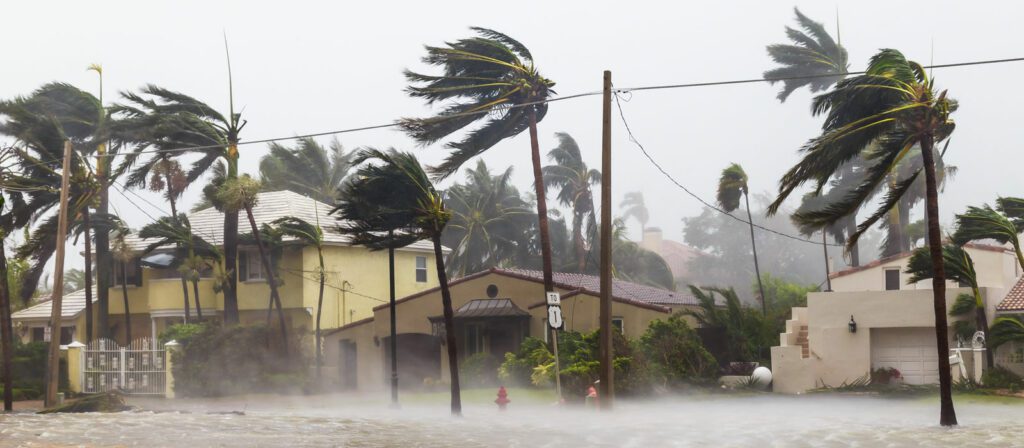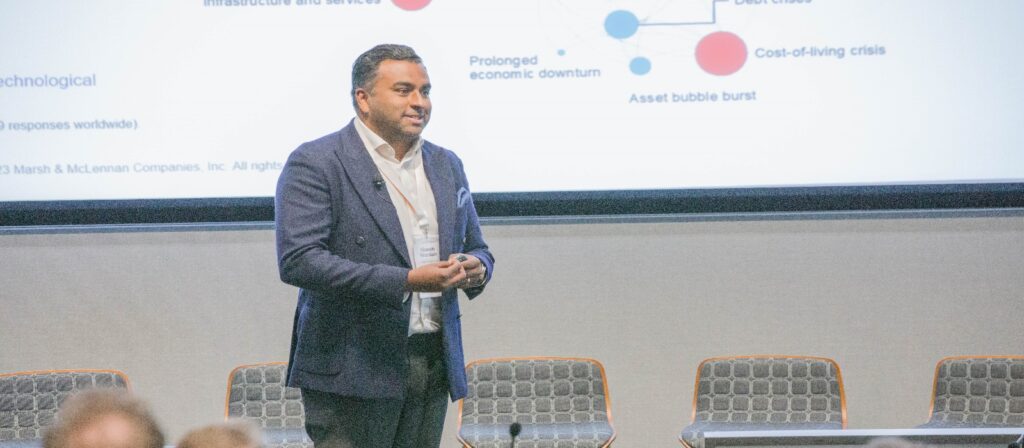This year's emerging risk insights reflect the uncertainty currently shaping the global risk landscape of the insurance industry, including geopolitical tensions, volatile financial markets and technological innovations such as generative AI.
The world undergoes constant change, and this gives rise to what we term “emerging risks”. These are new and changing risks that are difficult to quantify, yet can have significant impact on the insurance industry.
Swiss Re identifies emerging risks by gathering signals and feedback from underwriters, client managers, risk experts and others across the organisation, and also from external specialists and research institutions. With the annual SONAR report, published since 2013, we aim to foster dialogue with all stakeholders to better understand and manage emerging risks.
The 2023 SONAR report features 13 new emerging risk themes1 and four emerging trend spotlights2 (see below).
The emerging risk themes are potential new or changing risks, with both downside risks and upside potential for the insurance industry. The “trend spotlight” items highlight contextual developments we deem relevant for insurers, without necessarily profiling a specific risk.


This article based on the results from the Swiss Re Institute’s 2023 SONAR emerging risks survey was reproduced with the kind permission of ICMIF Supporting Member Swiss Re.
To access the full in-depth article, including interactive graphics, please visit this Swiss Re Institute webpage.
Published December 2023
Turbulent times
Geopolitical tensions and financial market volatility persist in the post-pandemic world marked by the war in Ukraine, rising interest rates and inflation. In parallel, global polarisation and conflict may give rise to mutually exclusive markets. Even the risk of nuclear events is heightened. Inflationary pressures bring into question the sustainability of sovereign debt across the globe. The threat of a new pandemic still looms. The recent outbreaks of Avian influenza are the largest to date, in different parts of the world.
Technological innovations impact society and business
Technological advances continue to drive societal and economic change. The spread of the digital economy offers new opportunities for insurers, such as embedded insurance or cost savings in product testing, design and maintenance with the integration of digital twins. But the expanding use of machine learning systems will expose more services to potential flaws and manipulation. Increased digitalisation of various services, such as growing reliance on digital payments, brings about new vulnerabilities of power shortages and cyberattacks that may paralyse large sectors of the economy. Digitalisation also raises questions around ownership and liability, as is the case with the rise of generative artificial intelligence.
New risks from advances in health and environmental concerns
Growing concerns around the mental health impacts from addictive online platforms are putting liability pressure on social media platform providers. Medical innovations in drug development and care technology make it more difficult to predict mortality and morbidity trends. While life expectancy among a rapidly ageing population is growing, healthy life expectancy is not increasing at the same pace.
New risks arise from toxic chemicals introduced decades ago that are now being scrutinised for their potential to harm people and the environment. The need to reduce pollution and resource depletion in the future is accelerating the circular economy. But new liabilities emerge as businesses need to rethink entire logistics concepts to promote sustainable recycling.
Other new emerging risks include dangers from solar radiation management, which aims to reverse climate change, and the unknown long-term health risks from weight-loss injections that are intended to manage obesity but are becoming popular for aesthetic use in non-overweight people as well.
New emerging risk themes
Several advances in medicine are leading to longer lives, changing mortality expectations and creating new insurance opportunities.
Potential impacts
- Uncertainty around the outcome of innovations in disease detection and diagnostics, drug development and care technology, among others, make it more difficult to accurately predict mortality and morbidity trends.
- Modelling for Life & Health (L&H) lines will be impacted, as will sector profitability forecasts.
- Medical malpractice and product liability claims for new therapies/treatments designed to extend lifespan can be expected.
Impact Medium
Time frame >3 years
The recent outbreak of Avian influenza is the largest ever and has killed millions of birds globally. Transmission of the H5N1 virus from birds to other animals and (even) humans can trigger a range of insurance policies.
Potential impacts
- In more mature markets, producers affected by government slaughter orders typically receive compensation. Payment may come from a compulsory livestock epidemic fund financed with insurance levies from livestock holders and/or government contributions, or directly from state budgets.
- Private insurance can help cover the difference (if any) between state-sponsored cash compensation and the market value of lost livestock and/or business interruption costs.
- There can also be workers’ compensation claims, for farm workers infected with the virus.
- There can be claims and losses from agents in the overall food distribution chain due to shortages, in the case of birds, supply of eggs and poultry.
- Virus migration to humans at large scale (which is theoretically possible but has not yet happened) could impact mortality and morbidity covers.
- A learning from COVID-19 is that an influenza epidemic/pandemic increases interest in L&H cover. The affordability for such insurance remains a concern in many parts of the world.
- In case of an extreme pandemic or epidemic, travel restrictions and lockdowns may kick in, leading to supply chain interruptions and financial market impacts.
Impact Medium
Time frame 0 - 3 years
Interest rate hikes come at a time when public debt levels are at historic highs, reducing purchasing power and making insurance less affordable.
Potential impacts
- The rising cost of debt can call into question government finances and expose latent vulnerabilities built up among financial markets participants that leveraged up in the low-yield, low-volatility interest rate regime.
- High sovereign debt burdens could lead to reduced investment in infrastructure and public services, leading to potentially more failures in critical infrastructure and health services.
- A decline in growth-oriented public investment could lead to higher unemployment, falling productivity and, potentially, social unrest. The latter could trigger credit and surety (C&S), property, business interruption (BI) and political violence (PV) covers.
- In parallel, the current cost of living crisis could exacerbate the debt crisis by weakening consumer purchasing power, leading to a decline in insurance purchases and ultimately diminishing societal resilience.
Impact Medium
Time frame 0 - 3 years
Free markets facilitate global re/insurance business. Further polarisation of geopolitical alliances could lead to mutually exclusive markets and impede global re/insurance businesses.
Potential impacts
- Loss of access to a market on account of fragmentation of the global economy into regional blocs would have negative premium impacts. Protectionist measures could result in lower growth. Regulatory uncertainty affects long-tail business in particular.
- Complexity of geopolitical alliances and sanction regimes increases legal and compliance risk and costs for re/insurers.
- Operational challenges also include potential breakdowns of supply chains, threats of cyberattacks and commercial espionage.
- Liability and asset portfolios could come under stress in case of military conflict, and there could be strains on liquidity management, this increasing cost of capital.
Impact High
Time frame 0 - 3 years
Climate change is driving the “Arctic opening”, giving rise to new shipping and trade routes. The economic and strategic potential of the region is growing. So too are the potential for environmental exposure and geopolitical frictions. These hamper cooperation and governance, creating new and emerging risks.
Potential impacts
- Demand for insurance related to economic activities in the Arctic region – ranging from trade (marine), to fishing, to mining and to tourism, is likely to grow.
- Economic and geopolitical uncertainties bring strategic and reputational risks.
- Potential for business disruptions in the region, and also for secondary effects on global supply chains is elevated.
- Arctic opening and permafrost melt give rise to environmental risks, which could impact property and specialty lines of business. Pollution could trigger casualty insurance policies.
- The release and migration of pathogens formerly frozen in ice and permafrost could be the source of new epidemics/pandemics.
- Cooperation among the eight member states of the Arctic Council has been suspended, fostering governance, regulatory and legal uncertainties. These will impact also the regulatory framework for insureds and insurers.
- The prospect of military conflict in the region has increased, changing the risk landscape for entities active in the region and their insurers.
Impact Medium
Time frame 0 - 3 years
Nuclear energy facilities can suffer damage from different sources: war, intentional interference by hostile parties, unintentional mishaps in daily operations or maintenance, and damage from catastrophic natural hazards. Radiation release from any such event can trigger insurance claims across many lines of business.
Potential impacts
- Economic activity in the region of the radiation release could slow significantly or come to a standstill, potentially impacting financial markets globally.
- Even a small-scale radiation release event can trigger claims for property losses.
- Radiation events can lead to supply chain disruptions and contingent business interruption.
- Human exposure to radiation could trigger claims in mortality and morbidity in L&H insurance on account of sudden death and illnesses that people subsequently suffer.
- A release event may lead to shortages of food and other life necessities (eg, clean water and energy).
Time frame 0 - 3 years
Attention-grabbing online platforms weigh on peoples’ ability to concentrate and are being linked to poor mental health outcomes. The companies profiting from the attention economy may face increasing liabilities in the future.
Potential impacts
- Overuse of digital platforms is associated with depression, anxiety, sleeping problems and others. This may result in long-term mental health issues, leading to disability and, in severe cases, mortality claims.
- Mental illness and a more sedentary lifestyle come with co-morbidities such as obesity and cardiovascular diseases.
- Overuse of digital platforms can be distracting and lead to omissions in safety-critical functions (eg, system steering roles, security guards, etc) or accidents. This could impact liability lines of business: motor liability (car accidents), general liability, professional indemnity and employer liability/workers’ compensation (workplace accidents) insurance.
- Increasingly, the companies behind digital platforms may be held liable for negative effects experienced by users, creating a new risk landscape for them.
Impact Low
Time frame >3 years
The growing use and capabilities of Machine Learning (ML) systems come with new vulnerabilities. Insufficient awareness and governance will expose increasing numbers of services to new attacks.
Potential impacts
- The widespread use of AI and its systemic vulnerabilities raise concerns that adversarial ML could lead to risk/loss accumulation.
- Model evasion could impact automated insurance claims processing and facilitate fraud.
- Fraudsters might target the ML systems used for insurance distribution and pricing, leading to unwanted shifts in risk exposure.
- Professional liability lines: ML system failures or data breaches could trigger software producers’ or distributors’ professional indemnity and errors and omissions' (potentially also directors and officers') claims.
- Public reports of hacks/adversarial ML attacks could cause reputational damage.
- Targeted data poisoning could lead to unexpected high failure rates and, for instance, in case of autonomous cars or medical diagnosis software, trigger casualty or health claims.
Impact High
Time frame >3 years
Reflecting the sun’s energy to address climate change effects is gaining more attention as the impacts of global warming become more visible. But the process, known as solar radiation management (SRM), comes with many risks.
Potential impacts
- Manipulating climate via SRM can lead to extreme weather events including flood, drought, and windstorms, these triggering property losses and other claims.
- The release of compounds into the atmosphere impacts many countries. The nation which deploys SRM may not be the one that suffers harmful side effects. Deciding which legal frameworks and governance for negative side effects to apply will be important.
- Atmospheric climate engineering may shift the zones for communicable diseases, heat stress and extreme weather events, which can trigger new mortality and morbidity patterns. Such shifts can impact L&H business.
Impact Medium
Time frame >3 years
Advances in attribution science of chemicals and a change in environmental regulations have the potential to trigger property damage or bodily injury in the present day on account of chemicals having made it into the environment way back in the past.
Potential impacts
- New scientific methods and computation power are making it easier to attribute chemicals to their sources and to discover previously not visible connections between chemicals, environmental impairment, property damage and/or bodily injury.
- In the context of strengthening legislation and regulation, these findings can lead to claims in general liability, directors and officers (D&O), and workers’ compensation insurance.
- The ubiquity and accumulation potential of certain chemicals over the long term makes this a long-latent and serial-loss damage type of risk. Stakeholders across the chemical production, distribution, use and disposal value chain could be impacted.
Impact Medium
Time frame 0 - 3 years
The COVID-19 pandemic propelled the use of digital payments with people embracing online shopping as never before. What risks does the cashless economy bring?
Potential impacts
- Claims related to malfunction of software and hardware systems at point of purchase/transaction are likely to increase.
- Liability claims related to power outages, cyber attacks and natural disasters that result in digital payment system shutdowns or malfunctions may occur.
- Even a seamlessly operational digital/cashless economy entails the risk of discrimination claims. These could come from consumer protection/interest groups seeking compensation for individuals/shares of populations excluded from the market because they still use cash.
- Ability of customers to rapidly transfer money digitally increases the risk of bank runs and can have ripple effects on the financial markets.
- A shift from physical burglary to money-transfer crime.
- A cashless economy creates a new product segment for cyber insurance.
Impact Medium
Time frame 0 - 3 years
Weight-loss injections are rising in popularity and show potential in the management of obesity. But uncertainty remains over long-term risks to health, and there are also concerns regarding the use of the injections for aesthetic weight loss in unintended (ie, not obese, not overweight) populations.
Potential impacts
- Potential product liability claims against drug manufacturers, distributors and retailers, where use of the drugs lead to unexpected adverse health impacts.
- The outcome of potential class actions could go beyond the pharma industry, for instance to pharmacies and distributors also.
- Medical malpractice or professional indemnity claims against doctors and pharmacies due to use of weight-loss drugs in populations that do not meet the indication criteria.
- Potential unknown long-term health impacts could affect longevity and morbidity.
- Cosmetic use might cannibalise medical-indicated use for diabetes, causing inequity and drug shortages.
Impact Low
Time frame 0 - 3 years
Emerging trends spotlights
Many emerging risks in L&H are not related to epidemiological or life-science developments but to the reliability of energy and clean water supplies.
Morbidity expectations underpin health insurance, while life and longevity insurance solutions are based on mortality forecasts. COVID-19 was a reminder, however, that morbidity and mortality forecasts alone may not suffice for L&H sector predictions of the future.
Other important risk drivers often not taken into account include the reliability of energy and clean water supplies. These become especially important when a well-functioning healthcare system is needed most: in times of crisis.
Many other risk drivers have been on our radar for some time, also. For example, as populations age, the number of people vulnerable to communicable diseases increases. At the same time, however, some key issues like antibiotic resistance or underinvestment in vaccines remain unresolved. Such risk factors can compound the risks the insurance industry is already exposed to, such as increased morbidity and mortality in the case of epidemics/pandemics.
Over the last 10 years, two long-term global trends are especially prominent: climate change and the destruction of nature. Both bring their own health-related hazards while simultaneously reinforcing one another.
Actuarial modelling should adapt to account for both the positive (eg, in the field of medical innovation) and negative factors that could influence morbidity and mortality trends. The L&H industry should look beyond the traditional focus of health-related data to address new risk drivers. For instance, climate change modelling or risk mitigation for infrastructure related business interruption are already topics in non-life insurance segments for decades. Such insights can help in the task ahead: having a fresh look at scenarios and how to adapt to the qualitative risk changes the world is going through.
Digital twins are being integrated across all industries, yielding cost-savings in product testing, design and maintenance. However, widespread use of this technology, especially in combination with artificial intelligence, could increase the risk of systemic product liability and recall claims. It also raises concerns about privacy and cybersecurity.
By bridging the gap between the virtual and the real worlds, digital twins are powering a “fourth industrial revolution”. The twins are digital replicas of physical objects (eg, a car) or systems (eg, a production line). They enable virtual modelling to analyse and optimise real-world products and processes.
Digital twins can facilitate cost-reduction and operational efficiencies. They can be used to plan maintenance, spot emerging problems, and simulate the effect of upgrades and design changes.
The versatility of digital twins and their rapid integration across sectors is likely to bring benefits to P&C insurance. In manufacturing, the predictive maintenance capacity of the twins is likely to reduce overall claims in product liability and recall. Data-driven, real-time tracking of key process parameters can also help reduce product quality issues. In production facility planning (or other environments with man-machine interaction), digital twins can identify potential threats to worker, contractor and visitor safety, and even long-term ergonomics, ultimately reducing employer’s liability and worker compensation claims. In motor insurance, when applied to autonomous car features, twins can help reduce accident frequency and severity. Their application to process management or supply chain optimisation can reduce business interruption risks. Digital twins of assets can also be stress-tested against a pre-selected series of events (eg, storms, earthquakes or infectious disease outbreaks), to provide risk insights and increase resilience.
Given the need for supercomputing capabilities and know-how, there is a risk that the development of digital twin software becomes concentrated among a few major players. Professional indemnity and product liability losses could be invoked for digital twin software and data providers in cases where the software or virtual assumptions are the root-cause of a fault event.
In cases where digital twin technology is integrated with the Internet of Things (IoT) and artificial intelligence (AI), there is risk of systemic losses if AI is used in real-time to provide decisions on operation of the IoT assets. This risk is high since, due to their complexity, AI decision-making processes are often untraceable.
Creating digital replicas also raises questions around privacy and cybersecurity. The operation of many digital twins is based on information provided by a multitude of sensors that track real-world data and movements. There are also challenges in defining data ownership and intellectual property rights, especially in the case of third-party providers of digital twin software.
The rapid development of generative artificial intelligence (AI) systems opens opportunities for underwriting and claims processes. It also raises questions of ownership and associated risks.
The collection of the large data sets, which form the core of generative AI models, raises questions around ownership of the data, and also concerns about data quality and biases.
Class actions against the technology sector poses a risk for the insurance industry, as this can be expensive. While legal disputes, together with existing and new legislation, will help establish some guiding principles, the AI industry will likely adapt to new tech-generated disruption in similar fashion to other sectors that have been disrupted by innovation.
Another risk relevant for the insurance industry is that publicly-available generative AI systems can discourage people to seek professional medical, legal or financial advice. These systems make predictions using training data only. They do not access real-time data and thus may generate misleading information.
The question comes down to the quality and quantity of data used in the development of generative AI systems.
If the training data is too limited, biased or is incorrect, the predictions/answers generated will likewise be biased and inappropriate. This could lead to medical malpractice claims or professional liability lawsuits. On the other hand, generative AI models can be trained on a company’s proprietary knowledge base and processes. For example, insurers could deploy generative AI models to improve the efficiency of in-house manual underwriting and claims processes.
Today's digitalisation of almost any purchase and customer interaction creates new opportunities for embedded insurance solutions. But it also comes with risks...
Embedded insurance solutions have been a growing trend for years and many insurers already have said offerings in their portfolios. The concept is the real-time bundling in and sale of insurance covers as part of another product or service, bringing the risk protection directly to the consumer at the point of sale.
With digitalisation, partnerships between insurers, tech companies and non-insurers have enabled seamless addition of risk protection solutions to products that consumers access/purchase online. Some covers leverage usage-based and behavioural data to individualise risk pricing.
Examples of embedded insurance are policies offered or included when renting properties, vehicles or buying secondhand goods.
Often embedded insurance solutions cover a low sum insured, meaning that a critical mass of insureds is required for the business to remain sustainable. Without, the low premium volumes will not offset fixed costs from insurers and their partners.
Due to the distribution model (ie, sale as part a company’s core service or product), the embedded insurance offering has to be simple. Oversimplified policy terms could make both consumers and insurers more vulnerable to uncertainties or misunderstandings which could lead to more claims and litigation costs. As consumers get used to a faster and simpler process of buying insurance, the expectation builds that claims and pay-out processes follow the same speed and degree of automation. This expectation may not always be met by insurance companies.
An industry challenge is that if consumers become used to having insurance embedded in other products or services, they may not seek other forms of cover that they need, assuming they are covered when they are not. On the other hand, embedded solutions could also lead to consumer complaints on the grounds of being led into buying unnecessary insurance, or ending up being over-protected by purchasing a cover that is written into another already-owned policy, such as home insurance.
SONAR
SONAR stands for Systematic Observation of Notions Associated with Risk. It is Swiss Re’s process for identifying, assessing and managing emerging risks. Experts across the company use a web-based platform to collect early signals of emerging risks. All signals are assessed and prioritised by an emerging risk management team, which works closely with topic experts from Swiss Re’s different business areas. The team serves as a catalyst for risk identification and assessment to define and implement recommendations in collaboration with the business. The findings are regularly shared internally and summarised for external audiences.
Emerging risk themes illustrate potential new or changing risk developments for the insurance industry. They are mainly derived from SONAR but also draw on other sources. All themes have been assessed and edited by Swiss Reʼs emerging risk management experts.
1This research only features new emerging risk themes (ie, topics covered in previous editions are not listed again). You can retrieve prior reports from our webpage: www.swissre.com/sonar
2These are emerging trends which could become relevant for the insurance industry and its clients. The selection of topics is non-exhaustive, and descriptions are intended as food for thought and discussion starters rather than comprehensive reviews.





